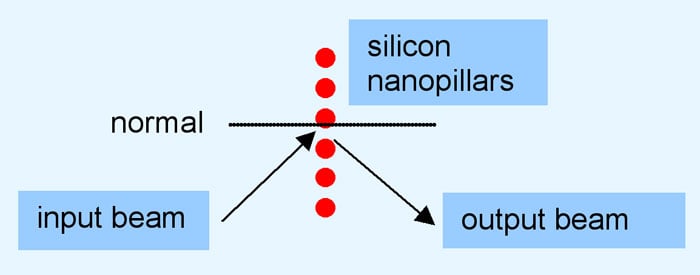
Theorists in China and the US claim that infrared light shone onto a line of silicon nanopillars can be bent by 90° as it travels through the material – without being reflected at all. This finding, if confirmed experimentally, would offer a novel approach to optical beam steering, which usually requires specially crafted “metamaterials”. The researchers say that the line of pillars could be used to bend beams of light in photonic circuits, possibly helping to steer light inside the components used in optical networks.
Junjie Du of the Chinese Academy of Sciences in Shanghai and his colleagues have considered the consequences of shining infrared light at two specific wavelengths – 1550 nm and 2362 nm – onto a line of 15 nanopillars at an angle of 45°. All of these half-micron-wide pillars are made from silicon, rather than the metal components typically found in metamaterials, because absorption losses are lower.
Resonating pillars
According to the researchers, each pillar will resonate when excited by infrared light to set up a standing wave inside it. The precise wave pattern is determined by the wavelength that the incident light has in silicon, which is about one-third of its value in air. Each pillar essentially behaves like an antenna, absorbing light and re-emitting it in a form possessing the symmetry of the standing wave inside the cylindrical nanostructures, with the light from the pillars interfering constructively or destructively, depending on the direction of the incident light.
Du’s team found that the pillars resonate like an electric dipole when excited by infrared light at 1550 nm. As the pillars are arranged in a line, emissions from each dipole interfere constructively when light of this wavelength is used and a single beam of light emerges from the same side of the normal as the incoming beam in what is known as negative transmission.
When 2362 nm light hits the line of silicon nanopillars, an isotropic standing wave is formed and radiation exits in four orthogonal directions. In contrast, working at a wavelength of 1550 nm creates a dipole symmetry in the pillars that completely suppresses the incident beam and its reflection – that is, the only beam transmitted is at right angles to the incident one and it is negatively refracted. “The outgoing beam makes a sharp turn and lies on the same side of the normal as the incident beam,” explains Du. “At the same time, the conventional reflected and transmitted beams disappear.”
Practical benefits?
Several technologies have already been proposed for steering light beams through photonic circuits. Two options are flat dielectric gratings and vastly scaled-down versions of a Yagi–Uda antenna, an aerial popular with amateur radio enthusiasts. However, Du says that the fabrication of both of these structures is challenging as they contain many elements of different sizes. Producing a nanopillar array is relatively easy, because each pillar has the same radius.
Another steering option is to use photonic-crystal structures, which guide radiation using an array of small holes with diameters similar to the wavelength of light in free space. However, Du believes that nanopillars have the upper hand, because light guiding is possible with arrays that contain fewer elements.
The team is now putting its theory to the test with an experiment involving 4 μm-high silicon pillars. “We are also planning to further explore the role of symmetry in other resonance modes to manipulating the optical beam,” says Du.
The research is published in Physical Review Letters.




